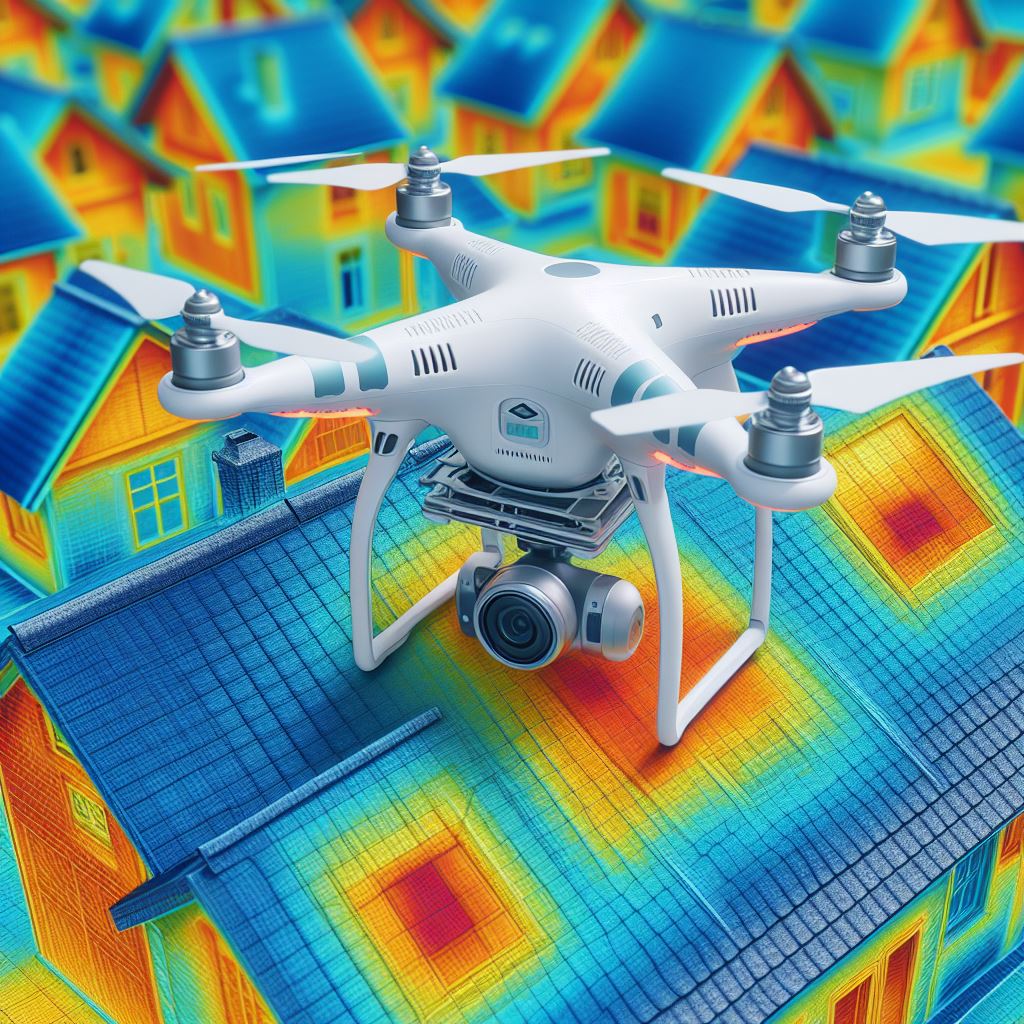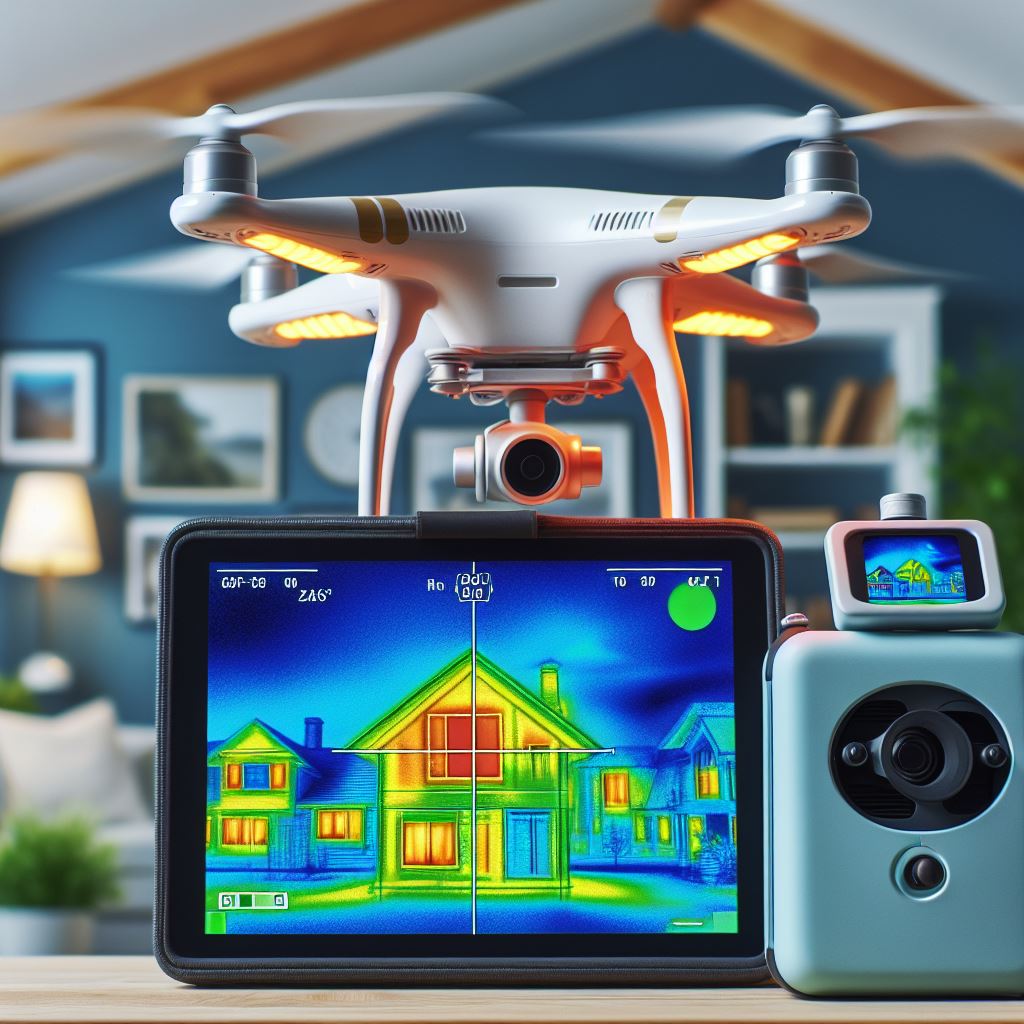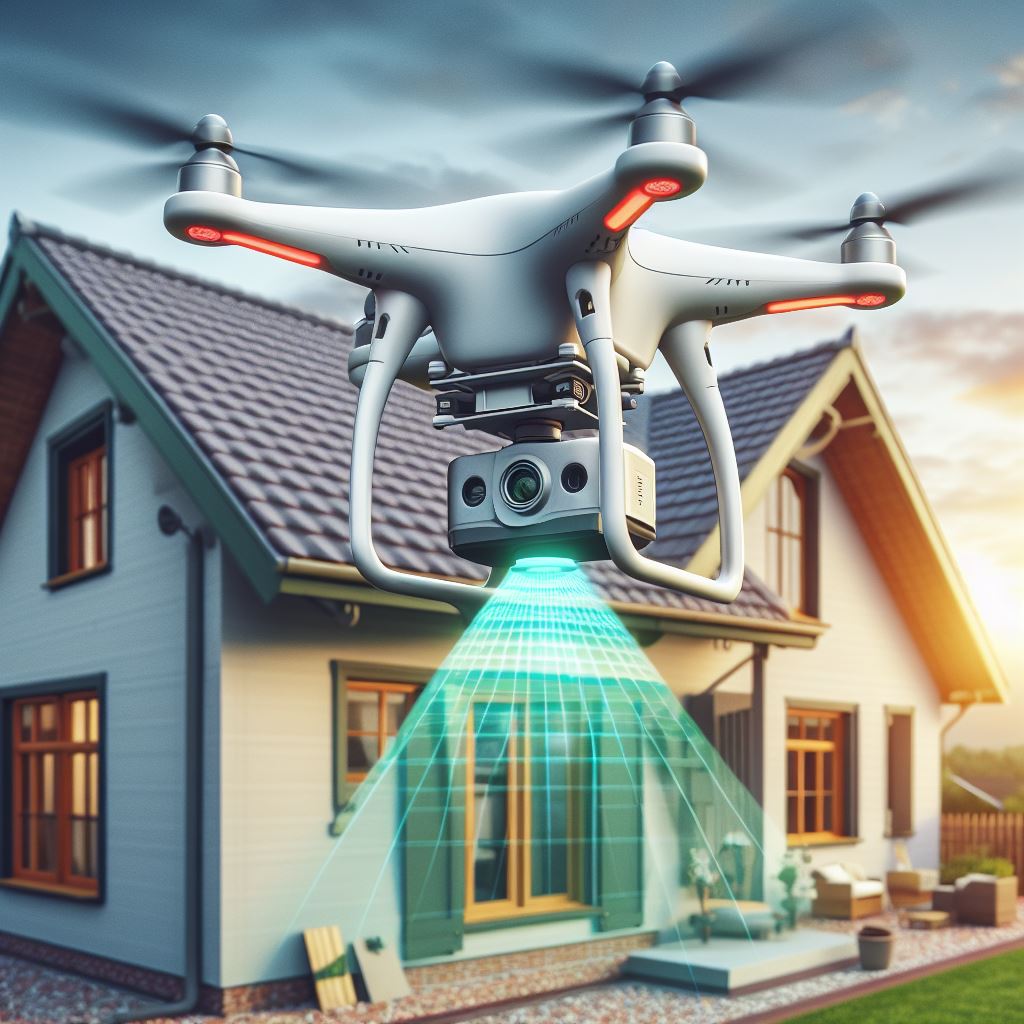Benefits of Using Drones for Home Inspection
Drones have become increasingly popular in various industries, including home inspection. These unmanned aerial vehicles offer numerous benefits when it comes to detecting damage in homes. In this article, we will explore the advantages of using drones for home inspection and how they are able to detect damage more efficiently than traditional methods.
One of the primary benefits of using drones for home inspection is their ability to access hard-to-reach areas. Drones can easily navigate through tight spaces, such as attics and crawl spaces, without the need for inspectors to physically enter these areas. This not only saves time but also reduces the risk of accidents or injuries that may occur in confined spaces.
Furthermore, drones equipped with high-resolution cameras can capture detailed images and videos of the entire property. These images provide inspectors with a comprehensive view of the home, allowing them to identify potential issues that may not be visible from the ground. By capturing images from different angles, drones can provide a more accurate assessment of the property’s condition.

In addition to capturing images, drones can also be equipped with thermal imaging cameras. These cameras detect temperature differences, which can indicate hidden issues such as water leaks or insulation problems. By using thermal imaging, inspectors can quickly identify areas of concern and prioritize necessary repairs or maintenance.
Another advantage of using drones for home inspection is the ability to create 3D models of the property. By combining aerial images with advanced software, drones can generate detailed 3D models that provide a virtual representation of the home. These models allow inspectors to examine the property from different perspectives and easily identify any structural or cosmetic damage.
Moreover, drones can be equipped with sensors that detect various types of damage. For example, drones can be fitted with gas sensors to detect leaks or airborne pollutants. They can also be equipped with sensors that detect moisture levels, which can help identify areas prone to mold growth. By using these sensors, inspectors can quickly identify potential hazards and take appropriate measures to address them.
Using drones for home inspection not only improves efficiency but also reduces costs. Traditional methods of inspection often require scaffolding or ladders to access certain areas, which can be time-consuming and expensive. Drones eliminate the need for these additional resources, resulting in cost savings for both inspectors and homeowners.
Furthermore, drones can cover large areas in a relatively short amount of time. This allows inspectors to complete inspections more quickly, enabling homeowners to receive reports and make informed decisions in a timely manner. The efficiency of drone inspections also reduces the disruption to homeowners, as inspections can be completed without the need for prolonged visits or disturbances.
In conclusion, drones offer numerous benefits when it comes to detecting damage in home inspections. Their ability to access hard-to-reach areas, capture detailed images and videos, use thermal imaging, create 3D models, and detect various types of damage make them a valuable tool for inspectors. Not only do drones improve efficiency and accuracy, but they also reduce costs and minimize disruption to homeowners. As technology continues to advance, drones are likely to become an increasingly integral part of the home inspection process.
How Drones Enhance Efficiency in Detecting Damage
In recent years, drones have become increasingly popular in various industries, including home inspection. These unmanned aerial vehicles (UAVs) have revolutionized the way damage is detected in homes, enhancing efficiency and accuracy. By utilizing advanced technology and aerial capabilities, drones provide a unique perspective that traditional inspection methods cannot match.
One of the primary advantages of using drones in home inspection is their ability to access hard-to-reach areas. Drones can easily navigate tight spaces, such as roofs, chimneys, and gutters, without the need for inspectors to physically climb ladders or scaffolding. This not only reduces the risk of accidents and injuries but also saves a significant amount of time. With drones, inspectors can quickly and safely examine areas that would otherwise be challenging to access, ensuring a thorough inspection.

Furthermore, drones equipped with high-resolution cameras and thermal imaging sensors can detect damage that may not be visible to the naked eye. These advanced imaging technologies allow inspectors to identify issues such as water leaks, insulation problems, and electrical faults with precision. Thermal imaging, in particular, is highly effective in detecting hidden moisture, which can lead to mold growth and structural damage. By capturing detailed images and thermal data, drones provide valuable insights that aid in the accurate assessment of a home’s condition.
In addition to their imaging capabilities, drones can also be equipped with other specialized sensors, such as gas detectors and radiation sensors. These sensors enable inspectors to identify potential hazards, such as gas leaks or radioactive materials, without putting themselves at risk. By remotely collecting data from hazardous environments, drones enhance the safety of home inspections and provide valuable information for further analysis.
Moreover, drones can generate 3D models and maps of properties, allowing inspectors to visualize the entire structure from different angles. These models provide a comprehensive overview of a home’s layout and can be used to identify potential structural issues, such as cracks or uneven foundations. By combining aerial imagery with advanced mapping software, drones enable inspectors to analyze the overall condition of a property more accurately.
The use of drones in home inspection not only enhances efficiency but also reduces costs. Traditional inspection methods often require multiple personnel and extensive equipment, which can be time-consuming and expensive. Drones, on the other hand, can be operated by a single inspector and require minimal equipment. This significantly reduces the overall cost of inspections while maintaining a high level of accuracy and thoroughness.
Furthermore, the data collected by drones can be easily stored and shared digitally, eliminating the need for cumbersome paperwork. Inspectors can access the information remotely, allowing for efficient collaboration with clients and other professionals involved in the inspection process. This streamlined approach not only saves time but also ensures that all stakeholders have access to the necessary information in a timely manner.
In conclusion, drones have revolutionized the field of home inspection by enhancing efficiency and accuracy in detecting damage. Their ability to access hard-to-reach areas, utilize advanced imaging technologies, and generate 3D models provides inspectors with a unique perspective that traditional methods cannot match. Moreover, drones reduce costs, improve safety, and streamline the inspection process through digital data storage and sharing. As technology continues to advance, drones are likely to play an increasingly significant role in the future of home inspection.
Advanced Technologies Utilized by Drones in Damage Detection
Advanced Technologies Utilized by Drones in Damage Detection
In recent years, drones have become increasingly popular in various industries, including home inspection. These unmanned aerial vehicles (UAVs) offer a unique perspective and have the ability to capture high-resolution images and videos from above. This technology has revolutionized the way damage is detected in home inspections, providing a more efficient and accurate assessment of potential issues.
One of the key technologies utilized by drones in damage detection is thermal imaging. Thermal cameras mounted on drones can detect temperature differences in the building structure, which can indicate potential damage or areas of concern. This technology is particularly useful in identifying issues such as water leaks, insulation problems, and electrical faults. By capturing thermal images from above, drones can quickly identify areas that require further investigation, saving time and resources.
Another technology commonly used by drones in damage detection is LiDAR (Light Detection and Ranging). LiDAR sensors emit laser beams that bounce off objects and return to the sensor, creating a detailed 3D map of the environment. This technology allows drones to accurately measure distances and detect even the smallest changes in the building structure. By analyzing the LiDAR data, inspectors can identify structural damage, such as cracks, shifts, or unevenness, that may not be visible to the naked eye. This enables them to make informed decisions about repairs or further investigations.
Furthermore, drones equipped with high-resolution cameras can capture detailed images and videos of the property from various angles. These images provide inspectors with a comprehensive view of the building, allowing them to identify potential issues such as roof damage, missing shingles, or deteriorating facades. By capturing these images, inspectors can assess the extent of the damage without the need for physical access to the property, reducing the risk of accidents or injuries.
In addition to visual inspections, drones can also be equipped with gas sensors to detect harmful gases or chemicals. This technology is particularly useful in identifying leaks in gas pipes or detecting the presence of hazardous substances. By flying the drone close to the source of the potential leak, inspectors can quickly assess the situation and take appropriate action to mitigate any risks.
The data collected by drones during the inspection process can be further analyzed using advanced software and algorithms. These tools can help inspectors identify patterns, anomalies, or potential risks that may not be immediately apparent. By analyzing the data, inspectors can make more accurate assessments and recommendations for repairs or maintenance.
While drones have undoubtedly revolutionized the home inspection industry, it is important to note that they are not a replacement for human inspectors. Drones are a valuable tool that complements the expertise and experience of inspectors, providing them with additional information and a different perspective. Ultimately, it is the combination of human knowledge and advanced technologies that ensures a thorough and accurate assessment of potential damage in home inspections.
In conclusion, drones have become an essential tool in damage detection during home inspections. The advanced technologies utilized by drones, such as thermal imaging, LiDAR, high-resolution cameras, and gas sensors, enable inspectors to identify potential issues quickly and accurately. By providing a unique perspective and capturing detailed data, drones enhance the efficiency and effectiveness of the inspection process. However, it is important to remember that drones are a tool that supports human expertise, and their use should be combined with the knowledge and experience of professional inspectors.
Future Implications of Drone Technology in Home Inspection
Drones have become increasingly popular in various industries, including home inspection. These unmanned aerial vehicles (UAVs) offer a range of benefits, such as cost-effectiveness, efficiency, and improved safety. In the field of home inspection, drones have the potential to revolutionize the way damage is detected and assessed. This article explores the future implications of drone technology in home inspection, focusing specifically on how drones can detect damage.
One of the primary advantages of using drones in home inspection is their ability to access hard-to-reach areas. Traditional methods of inspection often require inspectors to climb ladders or scaffolding to examine roofs, chimneys, or other elevated structures. This can be time-consuming, physically demanding, and potentially dangerous. Drones, on the other hand, can easily navigate these areas, capturing high-resolution images and videos that provide a comprehensive view of the property.
To detect damage, drones are equipped with advanced imaging technologies, such as high-definition cameras and thermal sensors. These sensors allow drones to capture detailed visual data, including images and videos, which can be analyzed by inspectors. For instance, thermal sensors can detect temperature variations, enabling inspectors to identify potential issues like water leaks or insulation problems. By analyzing the collected data, inspectors can accurately assess the extent of damage and recommend appropriate repairs or maintenance.
In addition to visual data, drones can also collect other types of data that aid in damage detection. For example, drones can be equipped with sensors that measure humidity levels, air quality, or even structural integrity. This additional data provides inspectors with a more comprehensive understanding of the property’s condition, allowing them to identify hidden or underlying issues that may not be immediately visible.
Furthermore, drones can be programmed to perform automated inspections, reducing the need for human intervention. This automation not only saves time but also ensures consistency in the inspection process. Drones can follow pre-defined flight paths, capturing images and data at regular intervals. This systematic approach enables inspectors to compare data from different inspections over time, identifying any changes or deterioration in the property’s condition.
The use of drones in home inspection also has implications for data analysis and documentation. The vast amount of data collected by drones can be processed using artificial intelligence (AI) algorithms, which can quickly analyze and interpret the data. AI-powered software can identify patterns, anomalies, or potential issues that may require further investigation. This automated analysis streamlines the inspection process, allowing inspectors to focus on interpreting the results and making informed decisions.
Moreover, the data collected by drones can be stored and accessed digitally, eliminating the need for physical documentation. This digitalization not only reduces paperwork but also enables easy sharing and collaboration among inspectors, contractors, and homeowners. The ability to access and review inspection data remotely enhances communication and facilitates timely decision-making.
In conclusion, the future implications of drone technology in home inspection are vast. Drones offer a cost-effective, efficient, and safe alternative to traditional inspection methods. With their advanced imaging technologies, drones can detect damage in hard-to-reach areas and provide comprehensive visual data for analysis. The ability to collect additional data, such as temperature or humidity levels, further enhances the accuracy of damage detection. Automated inspections and AI-powered data analysis streamline the process, while digital documentation improves communication and collaboration. As drone technology continues to advance, its potential in home inspection will undoubtedly expand, revolutionizing the way damage is detected and assessed.
